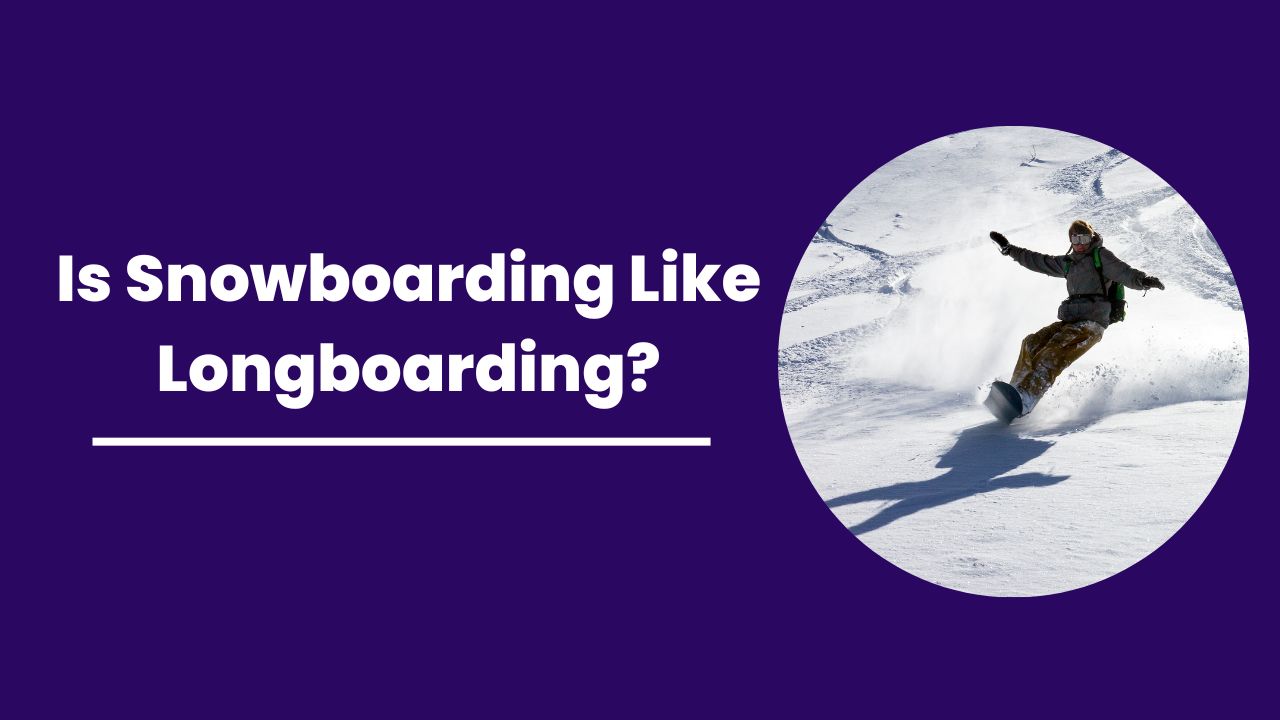Gliding across terrains, carving through turns, and embracing the rush of speed—snowboarding and longboarding epitomize the art of sliding across surfaces. The question arises: are these adrenaline-pumping pursuits more akin than meets the eye?
Exploring the parallels and distinctions between snowboarding and longboarding unveils a captivating narrative of shared techniques amidst vastly different terrains and equipment. Join us on a journey through the thrilling worlds of snowboarding and longboarding, where the pursuit of exhilaration unites, yet distinctive experiences define the path.

Contents
Is Snowboarding Like Longboarding?
Snowboarding and longboarding share some similarities, but they also have distinct differences. Here are the main points of comparison:
Similarities:
- Riding stance: Both sports involve standing sideways on the board and maintaining a similar stance while riding.
- Turning: The turning techniques used in both sports are quite similar.
- Board shape: Snowboards and longboards have a similar shape, although snowboards are generally longer than longboards.
Differences:
- Straps and bindings: Snowboarding requires riders to wear straps and bindings, which help them maintain their balance and control while riding on snow. In contrast, longboarding allows for more flexibility in foot positioning and does not require straps.
- Riding surface: Snowboarding takes place on snow, while longboarding is typically done on asphalt or other hard surfaces.
- Speed and stability: Snowboarding is generally considered more challenging and unstable at higher speeds compared to longboarding, as the rider’s feet are locked into the board and they have less control over their speed.
While longboarding can be a great way to cross-train for snowboarding during the off-season, it is not an exact substitute for the actual sport. However, the similarities in riding stance, turning techniques, and board shape make it a reasonable comparison.
Exploring the Link Between Snowboarding and Longboarding
At first glance, the connection between snowboarding and longboarding may seem apparent—a similarity in the thrill of sliding across surfaces. However, a deeper dive reveals nuances that distinguish these exhilarating activities.
Let’s unravel the similarities and differences between snowboarding and longboarding, two pursuits beloved by adventure enthusiasts.
Similar Techniques, Different Terrains
Both snowboarding and longboarding embrace the art of carving—the graceful movement through turns. The fundamental techniques involving weight shifting and balance are indeed parallel between these sports.
Yet, the major contrast lies in the terrains they conquer: snowboarding navigates snowy slopes, while longboarding cruises along pavements or hillsides.
An Insightful Comparison
| Aspects | Snowboarding | Longboarding |
|---|---|---|
| Terrain | Snowy slopes | Pavements/hills |
| Equipment | Board, boots, bindings | Longboard, helmet |
| Speed | Variable | Controlled |
| Environment | Mountain resorts | Urban or rural |
| Freestyle Opportunities | Terrain parks | Streets |
Real Facts to Consider
Snowboarding demands specialized equipment, including boots, bindings, and a board designed for snow. Conversely, longboarding involves a more straightforward setup, usually comprising a longboard and protective gear like helmets and pads.
Having engaged in both snowboarding and longboarding, the visceral thrill of gliding across surfaces remains consistent. However, the distinct environments and equipment nuances create unique experiences. Snowboarding evokes the rush of descending snow-covered slopes, whereas longboarding offers a sense of freedom while cruising through urban landscapes.
What is snowboarding comparable to?
Snowboarding is a sport that shares similarities with several other board sports, such as wakeboarding, skateboarding, and surfing.
Some of the key similarities and differences between snowboarding and these sports include:
Wakeboarding:
- Both sports require extreme balance and the use of a board to slide across a surface.
- Wakeboarding involves riding on a board behind a moving object, such as a boat.
- Strength and stamina are required for both sports.
- Edging on the board is important for turning and balance in both wakeboarding and snowboarding.
Skateboarding:
- Skateboarding and snowboarding share some similarities in terms of balance, coordination, and the ability to stay on your feet while moving quickly.
- Skateboarding can help snowboarders develop their skills and confidence with similar movements and techniques.
- However, there are differences in the way the sports are performed, such as the way riders maintain balance and the techniques used for turning.
Surfing:
- Both surfing and snowboarding rely on the sea and weather conditions.
- Surfers use their back foot to glide along the wave, similar to how snowboarders use their back foot to glide along the snow.
Skiing:
- Skiing is often described as more graceful and flowing, while snowboarding is considered more aggressive and powerful.
- Both sports require balance, coordination, and strength, but skiing requires more legwork than snowboarding.
- Skis are longer and thinner than snowboards, which affects the way the sports are performed.
In summary, snowboarding shares some similarities with wakeboarding, skateboarding, and surfing, but it differs in key aspects such as the way riders maintain balance, the techniques used for turning, and the equipment used. Skiing is also a close comparison, but it has its own unique characteristics that set it apart from snowboarding
What sport is longboarding?
Longboarding is a sport that involves using a longboard, which is a type of skateboard, to compete in various disciplines such as downhill racing, freeriding, freestyle, dance, and long-distance pushing. It originated in Hawaii in the 1950s and was inspired by surfboards.
Downhill longboarding, in particular, involves racing downhill at high speeds and is a popular form of competition. Longboarding offers physical benefits such as cardio and strength training, especially with longer races, making it a sport that provides a full-body workout. The sport is known for its sense of euphoria and adrenaline, particularly when racing downhill at high speeds.
Read More:
How Much Weight Can a Longboard Hold?
What Size Longboard Should I Get for My Height?
Is snowboarding a real sport?
Snowboarding is a recreational and competitive activity that involves descending a snow-covered surface while standing on a snowboard. It has its roots in skiing, surfing, and skateboarding, and it became an Olympic sport in 1998.
Snowboarding is considered a real sport by many, as it requires skill, balance, and physical fitness.
Some key aspects of snowboarding include:
- History: Snowboarding is believed to have originated in the United States, with several names, dates, and inventions contributing to its development. The modern snowboard was invented by Dimitrije Milovich, who founded Winterstick, the first modern snowboard company, in 1972.
- Olympic Sport: Snowboarding has been part of the Winter Olympics since 1998, with various events such as big air, halfpipe, parallel giant slalom, slopestyle, and snowboard cross.
- Popularity: Snowboarding is one of the world’s most popular sports, with millions of participants worldwide.
- Equipment: Snowboarders ride on snowboards, which are different from skis and do not require poles. The majority of participants wear soft-to-mid-flexing boots for support.
External Resources for Further Insight
For a deeper understanding of snowboarding and longboarding, resources like SnowboardingProfiles.com and Loaded Boards offer valuable insights into gear, techniques, and community experiences in these sports.
Conclusion: Embracing Diverse Thrills
In essence, while snowboarding and longboarding share commonalities in technique and thrill-seeking, their differences lie in the terrains, equipment, and environments they traverse. The joy of sliding across surfaces unites these activities, yet each offers a distinct adventure and experience for enthusiasts to cherish.
Understanding the connections and disparities between snowboarding and longboarding enriches one’s appreciation for these exhilarating pursuits. Whether carving through snow-covered mountains or cruising along urban landscapes, the thrill of gliding remains a constant, albeit in different forms and settings.

